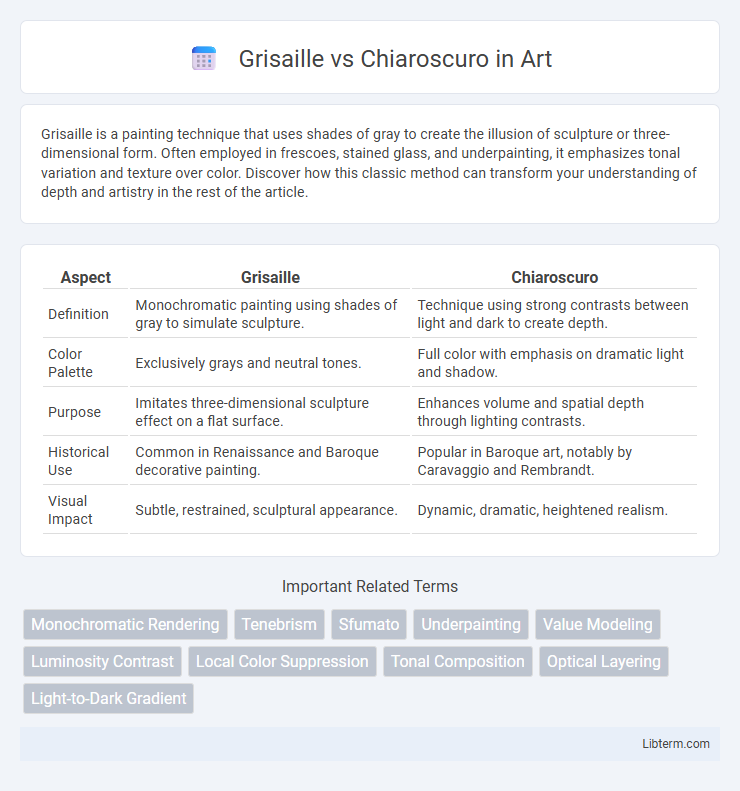Grisaille is a painting technique that uses shades of gray to create the illusion of sculpture or three-dimensional form. Often employed in frescoes, stained glass, and underpainting, it emphasizes tonal variation and texture over color. Discover how this classic method can transform your understanding of depth and artistry in the rest of the article.
Table of Comparison
| Aspect | Grisaille | Chiaroscuro |
|---|---|---|
| Definition | Monochromatic painting using shades of gray to simulate sculpture. | Technique using strong contrasts between light and dark to create depth. |
| Color Palette | Exclusively grays and neutral tones. | Full color with emphasis on dramatic light and shadow. |
| Purpose | Imitates three-dimensional sculpture effect on a flat surface. | Enhances volume and spatial depth through lighting contrasts. |
| Historical Use | Common in Renaissance and Baroque decorative painting. | Popular in Baroque art, notably by Caravaggio and Rembrandt. |
| Visual Impact | Subtle, restrained, sculptural appearance. | Dynamic, dramatic, heightened realism. |
Introduction to Grisaille and Chiaroscuro
Grisaille is a monochromatic painting technique using shades of gray to create the illusion of sculpture, often employed in underpainting or as independent artwork to emphasize form and volume. Chiaroscuro, originating from the Italian words for light and dark, enhances three-dimensionality by contrasting strong light and shadow, adding dramatic depth and realism to compositions. Both techniques play crucial roles in art history by manipulating light and tone to define shapes and spatial relationships.
Defining Grisaille: Techniques and History
Grisaille is a painting technique that uses shades of gray to create a monochromatic image, often employed to mimic sculpture or serve as underpainting for oil paintings. Originating in the Middle Ages, this method was popular for its ability to emphasize form and volume without the distraction of color, frequently seen in illuminated manuscripts and stained glass designs. Grisaille's precise use of light and shadow defines contours and depth, making it a foundational technique in both medieval and Renaissance art.
Understanding Chiaroscuro: Origins and Applications
Chiaroscuro, originating during the Italian Renaissance, is a technique that emphasizes the dramatic interplay of light and shadow to create depth and volume in two-dimensional art. Artists like Caravaggio and Leonardo da Vinci mastered this method to enhance realism and emotional intensity in paintings, contrasting sharply with Grisaille, which uses shades of gray to mimic sculpture. This technique remains influential in contemporary art and visual storytelling for its ability to convey intricate textures and three-dimensional effects.
Key Differences Between Grisaille and Chiaroscuro
Grisaille uses shades of gray to simulate sculpture or create monochromatic images, emphasizing form and volume without color. Chiaroscuro employs strong contrasts between light and dark to produce a sense of depth and three-dimensionality, enhancing dramatic intensity. While grisaille focuses on tonal gradation for subtle modeling, chiaroscuro relies on stark lighting contrasts for visual impact.
Artistic Purposes: When to Use Grisaille vs Chiaroscuro
Grisaille is ideal for studies, underpaintings, or creating a sculptural effect with its monochromatic palette that emphasizes form and volume without color distraction. Chiaroscuro excels in dramatic scene settings, utilizing strong contrasts between light and dark to enhance depth, emotion, and three-dimensionality in compositions. Artists should choose grisaille for subtle tonal modeling and chiaroscuro when aiming to evoke intense atmosphere and dynamic visual impact.
Notable Artists Who Mastered Grisaille
Notable artists who mastered grisaille include Jan van Eyck, renowned for his detailed monochromatic underpaintings that enhanced depth and texture in his works. Leonardo da Vinci also employed grisaille techniques in his preparatory studies to emphasize form without color distractions. Furthermore, Hans Holbein the Younger used grisaille to achieve striking realism in portraits, showcasing mastery in tonal variations.
Masters of Chiaroscuro in Art History
Chiaroscuro, a technique emphasizing strong contrasts between light and shadow, was mastered by artists such as Caravaggio, Rembrandt, and Leonardo da Vinci, who utilized it to create dramatic depth and volume in their paintings. Grisaille, in contrast, involves painting entirely in shades of gray to simulate sculpture or create underdrawings, often serving as a preparatory stage rather than a final effect. The profound impact of Chiaroscuro on Baroque and Renaissance art highlights the mastery of light manipulation by these iconic painters, elevating realism and emotional intensity in their works.
Visual Impact: Mood and Depth in Both Techniques
Grisaille employs monochromatic shades of gray to create a subdued, sculptural mood, emphasizing form and volume with subtle gradations of light and shadow that enhance depth through tonal modulation. Chiaroscuro, by contrast, uses stark contrasts between light and dark to generate dramatic intensity and three-dimensionality, producing a dynamic visual impact that heightens emotional tension. Both techniques manipulate light and shadow to convey depth, yet Grisaille offers a calm, architectural clarity while Chiaroscuro delivers a vivid, theatrical atmosphere.
Modern Interpretations of Grisaille and Chiaroscuro
Modern interpretations of grisaille emphasize its ability to create striking monochromatic artworks that highlight form and texture without color distractions. Contemporary artists use chiaroscuro to intensify contrasts between light and shadow, enhancing depth and dramatic effect in digital and traditional media. Both techniques continue to influence modern visual storytelling by merging classic principles with innovative materials and methods.
Conclusion: Choosing the Right Technique for Your Artwork
Grisaille and chiaroscuro each offer unique methods to enhance the tonal range and depth of your artwork, with grisaille emphasizing monochromatic subtlety and chiaroscuro highlighting dramatic contrasts between light and shadow. The choice depends on your artistic intent--opt for grisaille to achieve refined gray-scale nuances ideal for underpainting or detailed studies, while chiaroscuro excels in creating dynamic, visually striking compositions that emphasize volume and three-dimensionality. Understanding these distinctions allows artists to strategically select the technique that best complements their creative vision and desired emotional impact.
Grisaille Infographic

 libterm.com
libterm.com